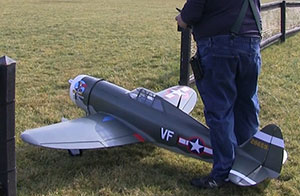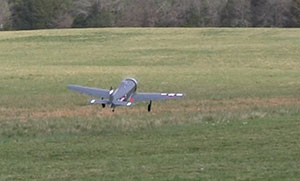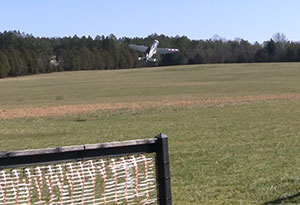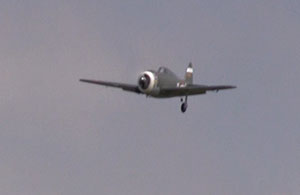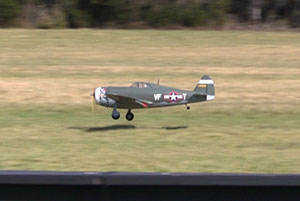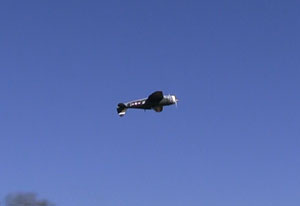Tom Hintz
50cc
Top-Flite Giant Scale P47 Razorback – Maiden 1
Top-Flite Giant Scale P47 Razorback – Maiden 1
Dialing in straight and level flight while tuning for our flying preferences
Text, photos and video by Tom Hintz
Flight video by Mike Basmajian
Posted – 2-29-2016
Maiden day for a new plane can elicit feelings that alternate between excitement and terror. To be sure, the first flight for any plane is high on the danger meter. However, a good inspection prior to the first flight will catch major issues that could actually kill a plane the first time out. I have maidened hundreds of planes and have never lost one, though there have been a few amazing saves. In those cases, “amazing†means that I don’t have a clue how the plane missed the ground/trees or other fatal obstructions. Despite the potential intensity I still like doing maidens.
With my own planes I consider the maiden to be a series of flights, not just one or two. It takes a while to get everything sorted out on a plane to make it comfortable throughout its flight envelope. We also have to remember that during the maiden process we are learning to fly that particular plane. As we go through the maiden process it is important to remember that a Top-Flite Giant Scale P47 Razorback will never fly like anAeroworks 50cc Edge 540 and trying to force any plane outside of its envelope is a great way to shorten the life of that plane dramatically.
Day One
The first maiden flight came on a warm but fully cloudy day with little wind initially. Two of my friends looked the Top-Flite Giant Scale P47 Razorback over and found some minor tweaks I needed to make from securing clevises better and three lock nuts on linkages that needed tightening. Little problems have a way of morphing into big, plane-threatening ones in short order.
I wasn’t overly happy about putting a camouflaged plane up in a totally gray sky for the maiden flight but knew if I kept it reasonably close I could maintain my orientation. After starting the EME60 and letting it warm up I taxied onto the (grass) runway and noted that the tail wheel was channeling a pogo stick as it passed over the lumpy surface. I think this tippy thing is more the fault of the lumpy runway surface than a deficiency in the Robart Retracts or the Top-Flite Giant Scale P47 Razorback itself.
Initial Trims
As soon as it broke free of the ground I could feel the nose wanting to go downward and the wings rolling slightly to the right. During the first lap around the field I pulled up the retracts, added several clicks of down elevator and a few clicks of left aileron. After that the Top-Flite Giant Scale P47 Razorback was remarkably stable with very little attitude change in response to throttle positions.
On a 45-degree up line the Top-Flite Giant Scale P47 Razorback wanted to nose over towards the ground. I tried the same thing up and down wind with the same results so decided that half of the 6 oz of the weight had added to balance the CG could come out for the next day of flying. I felt this was a reasonable change as the elevator was not feeling sensitive and the Top-Flite Giant Scale P47 Razorback was holding a decent line once the trims were set.
I had set the flap deflection to 2 3/8†(34-degrees) as the manual suggests but did not add any elevator change to go with it. On the initial landing passes the Top-Flite Giant Scale P47 Razorback wanted to nose up slightly as it slowed more than I was comfortable with. It did remain stable but it needed a few points of down elevator when the flaps are deployed to make landings even easier and more predictable. Between flights I added 3-points of down elevator and though the change was not dramatic it did encourage the Top-Flite Giant Scale P47 Razorback to keep the nose down just slightly which is far more comfortable to me during landing. By end of the first day landings were becoming far more comfortable.
Rudder
If you fly a lot of 3D type aircraft the rudder is going present a small learning curve. With the tail up on landing and take-off the Top-Flite Giant Scale P47 Razorback listens to the rudder very well. In the air the rudder has less “instant†effect which I suspect is far closer to realistic. In normal turns under reduced throttle the tail can want to drag towards the low wing and adding a bit of rudder will bring the tail up and make the turn look more coordinated.
I am slowly getting used to the Top-Flite Giant Scale P47 Razorback rudder due to my less than perfect history of applying too much rudder during landing approaches with other planes over the years. Those low-level, accidental snap rolls get your attention. So far the Top-Flite Giant Scale P47 Razorback has not done anything bad in response to the rudder I am using right now. But there is much more potential in the rudder that is going to take some experimenting on my part to make full use of.
My next day at the field will include a bunch of higher than normal landing approaches where I can feel out the rudder with greater safety. I have flown this plane in some wind, nearly always crosswind and in all other respects it is surprisingly stable. I am sure that once I boost my confidence in its rudder my comfortable envelope will expand considerably.
Landing
One of the things that most surprised me about the Top-Flite Giant Scale P47 Razorback is its low-speed stability and response. I can leave the nose down right to where I need to level the plane to avoid dorking the gear into the ground. The Top-Flite Giant Scale P47 Razorback does this very well and will surprise you with the amount of lift the wing is making when it is slow and low. I have been landing on the mains and have yet to have a major bounce. On one of the rollouts after setting the wheels down yesterday I was confident the Top-Flite Giant Scale P47 Razorback was slowing so I started adding a bit of elevator to get the tail wheel down. Instead, the plane lifted off the ground again but I caught it with the wheels just a few inches off the surface so I held it level and let is settle back to the ground.
The landing speeds can vary considerably with the Top-Flite Giant Scale P47 Razorback because of its expansive flight envelope. Though it can bounce around some in response to wind, when it gets close to the ground it seems to smooth out and the response of the ailerons and elevator remains crisp. I have not felt like the controls were going mushy even when I had the Top-Flite Giant Scale P47 Razorback going slower than intended. It’s probably still not smart to fly this warbird in high winds but I am certain it will handle a good bit more wind than many of the competing warbirds in this size.
Day Two
The day after Maiden day I returned to the field on a sunny, windless day that promised to be perfect for shaking out a new plane. I couldn’t have been more wrong. As I rolled on the gas for takeoff the tail came up and right about then the right main wheel came off. The retract strut stabbed into the grass, the retract was jerked out of the wing and the brand new Top-Flite Giant Scale P47 Razorback flopped right-wing-down and did a partial spin. As crashes go this one was fairly smooth. The right side retract was torn out of the wing but later when I started looking at the damage I found that it was fully repairable. I did a story on that repair in part because it illustrates how well this plane was designed and built. Click Here to see Fixing a Ripped-Out Retract.
More Research
Another segment of the Top-Flite Giant Scale P47 Razorback “trials†will come in a couple weeks. I need to get more used to the rudder to be sure we understand its capabilities. It would be easy to make an educated guess and say that the rudder on the Top-Flite Giant Scale P47 Razorbackworks fine. I would rather invest the time and make sure I understand any deficiencies (if there even are any) and what we can do about them. I am not hampered by editorial deadlines or advertising considerations so taking the time to know for sure so neither you nor I go astray just makes sense.
Stay Tuned
There will be one (I think) more segment in this review that will focus once again on flying the Top-Flite Giant Scale P47 Razorback. I don’t want to give the impression that this is a beginner’s plane because it absolutely is not. I can’t think of a warbird this side of a simple foamy that would be a good choice for a beginner. However, in the world of warbirds the Top-Flite Giant Scale P47 Razorbackis one of the best flying on the market and with qualified help many sport fliers should be able to learn how to handle this plane.
Top-Flite Giant Scale P47 Razorback – Maiden 1
Dialing in straight and level flight while tuning for our flying preferences
Text, photos and video by Tom Hintz
Flight video by Mike Basmajian
Posted – 2-29-2016
Maiden day for a new plane can elicit feelings that alternate between excitement and terror. To be sure, the first flight for any plane is high on the danger meter. However, a good inspection prior to the first flight will catch major issues that could actually kill a plane the first time out. I have maidened hundreds of planes and have never lost one, though there have been a few amazing saves. In those cases, “amazing†means that I don’t have a clue how the plane missed the ground/trees or other fatal obstructions. Despite the potential intensity I still like doing maidens.
With my own planes I consider the maiden to be a series of flights, not just one or two. It takes a while to get everything sorted out on a plane to make it comfortable throughout its flight envelope. We also have to remember that during the maiden process we are learning to fly that particular plane. As we go through the maiden process it is important to remember that a Top-Flite Giant Scale P47 Razorback will never fly like anAeroworks 50cc Edge 540 and trying to force any plane outside of its envelope is a great way to shorten the life of that plane dramatically.
Day One
The first maiden flight came on a warm but fully cloudy day with little wind initially. Two of my friends looked the Top-Flite Giant Scale P47 Razorback over and found some minor tweaks I needed to make from securing clevises better and three lock nuts on linkages that needed tightening. Little problems have a way of morphing into big, plane-threatening ones in short order.
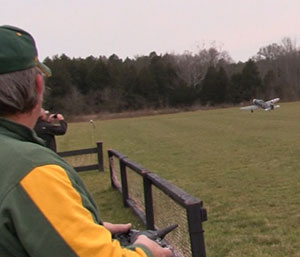
|
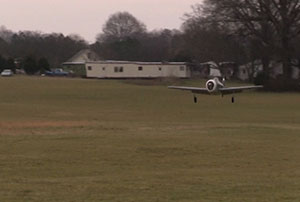
|
| The first take off (left) should lead to the first landing (right) if all goes well. this is where yo find out if everything is working right or if you have made a big mistake someplace. That's why having others look over your work is a great idea BEFORE the maiden flight. Click images to enlarge | � |
Initial Trims
As soon as it broke free of the ground I could feel the nose wanting to go downward and the wings rolling slightly to the right. During the first lap around the field I pulled up the retracts, added several clicks of down elevator and a few clicks of left aileron. After that the Top-Flite Giant Scale P47 Razorback was remarkably stable with very little attitude change in response to throttle positions.
On a 45-degree up line the Top-Flite Giant Scale P47 Razorback wanted to nose over towards the ground. I tried the same thing up and down wind with the same results so decided that half of the 6 oz of the weight had added to balance the CG could come out for the next day of flying. I felt this was a reasonable change as the elevator was not feeling sensitive and the Top-Flite Giant Scale P47 Razorback was holding a decent line once the trims were set.
I had set the flap deflection to 2 3/8†(34-degrees) as the manual suggests but did not add any elevator change to go with it. On the initial landing passes the Top-Flite Giant Scale P47 Razorback wanted to nose up slightly as it slowed more than I was comfortable with. It did remain stable but it needed a few points of down elevator when the flaps are deployed to make landings even easier and more predictable. Between flights I added 3-points of down elevator and though the change was not dramatic it did encourage the Top-Flite Giant Scale P47 Razorback to keep the nose down just slightly which is far more comfortable to me during landing. By end of the first day landings were becoming far more comfortable.
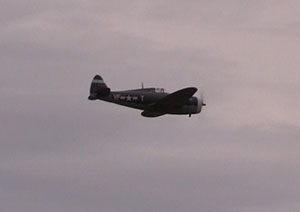
|
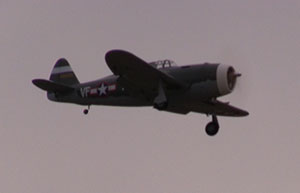
|
| Fast passes (left) look cool but you shold be jsut as inerested in how the plane handles a slow "dirty" pass (right) to start learning the models tendancies during landings. Click images to enlarge | � |
If you fly a lot of 3D type aircraft the rudder is going present a small learning curve. With the tail up on landing and take-off the Top-Flite Giant Scale P47 Razorback listens to the rudder very well. In the air the rudder has less “instant†effect which I suspect is far closer to realistic. In normal turns under reduced throttle the tail can want to drag towards the low wing and adding a bit of rudder will bring the tail up and make the turn look more coordinated.
I am slowly getting used to the Top-Flite Giant Scale P47 Razorback rudder due to my less than perfect history of applying too much rudder during landing approaches with other planes over the years. Those low-level, accidental snap rolls get your attention. So far the Top-Flite Giant Scale P47 Razorback has not done anything bad in response to the rudder I am using right now. But there is much more potential in the rudder that is going to take some experimenting on my part to make full use of.
My next day at the field will include a bunch of higher than normal landing approaches where I can feel out the rudder with greater safety. I have flown this plane in some wind, nearly always crosswind and in all other respects it is surprisingly stable. I am sure that once I boost my confidence in its rudder my comfortable envelope will expand considerably.
Landing
One of the things that most surprised me about the Top-Flite Giant Scale P47 Razorback is its low-speed stability and response. I can leave the nose down right to where I need to level the plane to avoid dorking the gear into the ground. The Top-Flite Giant Scale P47 Razorback does this very well and will surprise you with the amount of lift the wing is making when it is slow and low. I have been landing on the mains and have yet to have a major bounce. On one of the rollouts after setting the wheels down yesterday I was confident the Top-Flite Giant Scale P47 Razorback was slowing so I started adding a bit of elevator to get the tail wheel down. Instead, the plane lifted off the ground again but I caught it with the wheels just a few inches off the surface so I held it level and let is settle back to the ground.
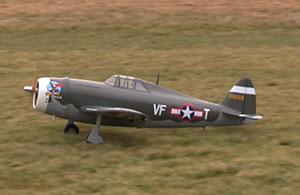
|
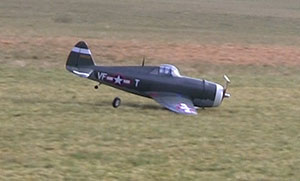
|
| This P47 has 5"-tall wheels (left) giving you an idea of how tall the grass is. that is certainly causing part of the tippy tendency. This is the first take-off of what wold have been Maiden day two (right).I must have missed the one set screw and the main wheel came off. I ws able to fix the P47 by the following Saturday. It now has several flights on the repair with no issues. Click images to enlarge | � |
Day Two
The day after Maiden day I returned to the field on a sunny, windless day that promised to be perfect for shaking out a new plane. I couldn’t have been more wrong. As I rolled on the gas for takeoff the tail came up and right about then the right main wheel came off. The retract strut stabbed into the grass, the retract was jerked out of the wing and the brand new Top-Flite Giant Scale P47 Razorback flopped right-wing-down and did a partial spin. As crashes go this one was fairly smooth. The right side retract was torn out of the wing but later when I started looking at the damage I found that it was fully repairable. I did a story on that repair in part because it illustrates how well this plane was designed and built. Click Here to see Fixing a Ripped-Out Retract.
More Research
Another segment of the Top-Flite Giant Scale P47 Razorback “trials†will come in a couple weeks. I need to get more used to the rudder to be sure we understand its capabilities. It would be easy to make an educated guess and say that the rudder on the Top-Flite Giant Scale P47 Razorbackworks fine. I would rather invest the time and make sure I understand any deficiencies (if there even are any) and what we can do about them. I am not hampered by editorial deadlines or advertising considerations so taking the time to know for sure so neither you nor I go astray just makes sense.
| Video Tour |
There will be one (I think) more segment in this review that will focus once again on flying the Top-Flite Giant Scale P47 Razorback. I don’t want to give the impression that this is a beginner’s plane because it absolutely is not. I can’t think of a warbird this side of a simple foamy that would be a good choice for a beginner. However, in the world of warbirds the Top-Flite Giant Scale P47 Razorbackis one of the best flying on the market and with qualified help many sport fliers should be able to learn how to handle this plane.

